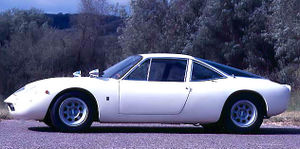Difference between revisions of "De Tomaso Vallelunga"
m |
m |
||
| Line 14: | Line 14: | ||
Unfortunately the chassis was not as stiff as one would have hoped, and drive train vibrations were a constant problem. Only 53 cars were built before it was quickly replace by the [[De Tomaso Mangusta]]. The Mangusta used the Vallelunga chassis re-engineered to take a [[Ford Boss 302 engine]] with a body by [[Giorgetto Giugiaro]]. | Unfortunately the chassis was not as stiff as one would have hoped, and drive train vibrations were a constant problem. Only 53 cars were built before it was quickly replace by the [[De Tomaso Mangusta]]. The Mangusta used the Vallelunga chassis re-engineered to take a [[Ford Boss 302 engine]] with a body by [[Giorgetto Giugiaro]]. | ||
| + | ==External Links== | ||
| + | Rosetti, Giancarlo. [http://www.europeancarweb.com/features/0502ec_de_tomaso_vallelunga/ De Tomaso Vallelunga Just the beginning for Alexjandro] ''European Car Magazine'' Accessed [[October 24]] [[2007]] | ||
| − | + | {{De Tomaso}} | |
| + | |||
[[Category:De Tomaso vehicles|Vallelunga]] | [[Category:De Tomaso vehicles|Vallelunga]] | ||
[[Category:MR layout vehicles]] | [[Category:MR layout vehicles]] | ||
Revision as of 12:26, 22 April 2008
The Vallelunga was an extremely rare mid-engined sports car produced by De Tomaso from 1965 through 1967.
History
The Vallelunga was based on a roadster designed by Carozzeria Fissore and named after the Autodromo di Vallelunga first shown as a concept car at the Turin Motor Show in 1964. De Tomaso had hoped to sell the design of the concept to another company, perhaps Ford, but when there were no takers had the car produced by Ghia.
Specifications
The engine was a 1.5L straight-4 Kent engine from the Ford Cortina with 104 hp (78 kW) at 6200 rpm. A Hewland transaxle was fitted. The chassis was a pressed steel backbone with tubular subframes. Suspension was double wishbone and coil springs at all four corners with uprights sourced from Triumph. The small car weighed just 726kg (1600lb) with a fiberglass body and loads of drilled aluminium parts. Brakes were disc all around.
Demise
Unfortunately the chassis was not as stiff as one would have hoped, and drive train vibrations were a constant problem. Only 53 cars were built before it was quickly replace by the De Tomaso Mangusta. The Mangusta used the Vallelunga chassis re-engineered to take a Ford Boss 302 engine with a body by Giorgetto Giugiaro.
External Links
Rosetti, Giancarlo. De Tomaso Vallelunga Just the beginning for Alexjandro European Car Magazine Accessed October 24 2007
De Tomaso Modena S.p.A. car timeline, 1960s–2010s
| ||||||||||||||||||||||||||||||||||||||||||||||||||||||||||||||||||||||||||||||||||||||||||||||||||||||||||||||||||||||||||||||||||||||||||||||||||||||||||||||||||||||||||||||||||||||||||||||||||||||||||||||||||||||||||||||||||||||||||||||||||||||||||||||||||||||||||||||||||
